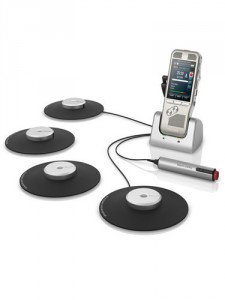 Recording a large group of multiple speakers, for example a meeting or focus group, requires specialist recording equipment. A simple and relatively inexpensive solution is to use a purpose built conference recorder. The example pictured is a Phillips DPM8900 Conference recorder.
Recording a large group of multiple speakers, for example a meeting or focus group, requires specialist recording equipment. A simple and relatively inexpensive solution is to use a purpose built conference recorder. The example pictured is a Phillips DPM8900 Conference recorder.
Crucially, the kit includes several boundary microphones, which when placed on a table, wall or other large surface, use the ‘boundary effect’ to capture a clear, phase coherent recording and they have a hemispherically shaped pick-up pattern.
The microphones should be placed so that ideally, all the speakers are all equidistant from a microphone.
The recording device pictured combines the signal from all the microphones and records them to a stereo audio file. Because the relative levels of the different microphones cannot be subsequently adjusted it is important to ensure good microphone placement at the outset.
(If you had a device capable of multi-track recording, then you would be able to adjust the level of each microphone channel at a later date using specialist audio editing software – but that’s a whole different ball game and quite costly!)
If you’re unsure about setting the recording level, just remember that it’s much easier to correct for a signal that’s too low than too high so err on the low side. Too high a level causes clipping, which is pretty much impossible to correct for – on our budget anyway!
Some simple tips for getting good audio:
- Turn off any fans in the room. If you have to use a fan, make sure that it is not placed on the same table as the microphones and not pointing directly at any microphones.

- Find a quiet room. Keep windows closed if there is noise outside. Even a little traffic noise can obscure dialogue.
- If you’re serving tea and coffee, don’t use saucers – they clatter very loudly – and the noise will be transmitted through the table to the microphones. Use rubber coasters to dampen the noise of cups being placed down on the table, you can get some very inexpensive ones – Ikea coasters pictured.
- Ask participants to speak one at a time. If at all possible, the chair or moderator should try to mention the speaker’s name – to introduce them or to thank them for instance – at each contribution. It is often very difficult for the transcriber to distinguish between voices. At the very least, ask each participant to identify themselves at the beginning of the recording.
- If you study or work at a university, often your department will have a ‘conference kit’ that you can borrow. This could save you some money!





